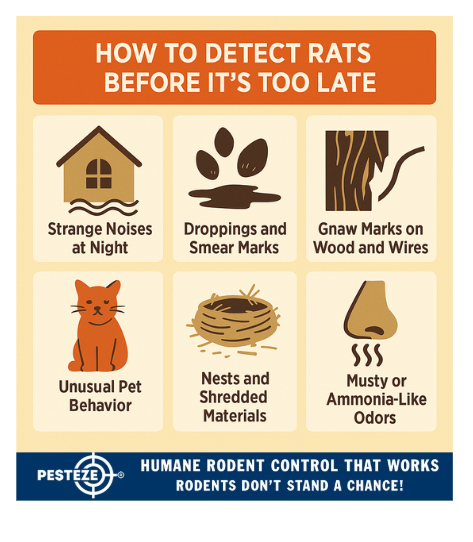HOW TO DETECT RATS BEFORE IT’S TOO LATE

HOW TO DETECT RATS BEFORE IT’S TOO LATE
SUMMARY
Rats are stealthy and often go unnoticed until the damage is done. Early detection is key to preventing infestation and protecting your home. Learn the subtle signs of rat activity so you can act quickly—before they take over your space.
FEATURES
• Strange Noises at Night: Scratching or scurrying in walls or ceilings
• Droppings and Smear Marks: Visible waste and greasy trails along baseboards
• Gnaw Marks on Wood and Wires: Rats chew to keep their teeth trimmed
• Unusual Pet Behavior: Pets may sense or hear rats before you do
• Nests and Shredded Materials: Paper, insulation, and fabric used for nesting
• Musty or Ammonia-Like Odors: Strong smells from urine or rat scent trails
DESCRIPTION
Rats are nocturnal, fast, and experts at hiding. By the time you actually see one, it’s likely that a larger infestation already exists. That’s why spotting early signs is essential to keeping your home safe from contamination, damage, and disease.
One of the first clues is unusual noises at night, particularly scratching, squeaking, or rustling sounds inside walls, ceilings, or under floors. These sounds usually occur after sunset, when rats become active and start foraging for food or nesting materials.
Droppings are another red flag. Rat droppings are small, dark, and pellet-shaped, typically found along walls, near food sources, or in corners. You might also notice greasy smear marks on baseboards—caused by rats rubbing their oily fur along their travel paths.
Keep an eye out for gnaw marks on wood, plastic, or electrical wires. Rats chew constantly to keep their teeth from overgrowing, which can lead to fire hazards and property damage. You may also notice shredded paper, fabric, or insulation in hidden areas—these are signs of nesting behavior.
Another subtle indicator is your pets’ behavior. Dogs or cats may bark, stare, or paw at walls or cabinets, sensing activity behind them. Pay attention to these signals—they might detect a rodent long before you do.
Lastly, a musty or ammonia-like smell may begin to linger in hidden corners or behind appliances. This odor comes from urine, droppings, or scent trails left by rats to mark territory and communicate with others.
By learning these early detection signs, you can take immediate steps—like sealing entry points, setting traps, or calling a professional—before a minor issue becomes a major infestation.
- Saharsh Bansal


Comments 0